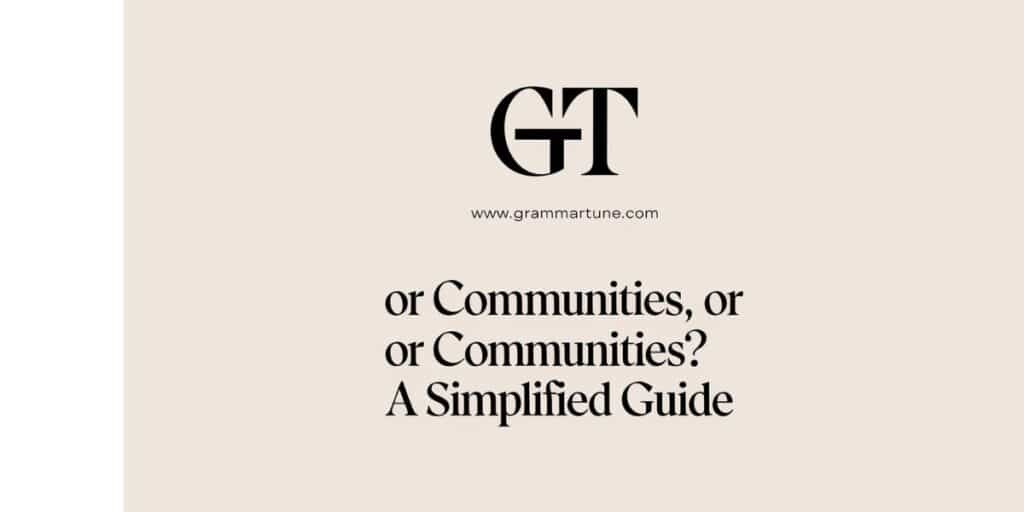Community’s, Communities’, or Communities? A Simplified Guide helps clear up the confusion surrounding possessive forms of community.
English grammar can be tricky, especially when it comes to deciding whether to use “community’s,” “communities’,” or “communities.” This guide breaks down the rules simply and effectively, so you don’t have to second-guess yourself.
Whether you’re writing for school, work, or personal projects, understanding the proper usage of these forms will improve your writing. Read on to discover the simple distinctions and ensure you’re always using the correct possessive form of community!
Table of Contents
- Introduction: Understanding Possessive Forms
- Community’s: Singular Possessive Form
- Example Scenarios
- Communities: Plural Form, No Possession
- Example Scenarios
- Communities’: Plural Possessive Form
- Example Scenarios
- Community’s vs. Communities’: The Key Differences
- Common Mistakes and How to Avoid Them
- How to Remember the Differences
- Practical Examples to Cement Your Understanding
- Real-World Applications
- Exercises to Test Your Knowledge
- Conclusion: Mastering Possessive Forms
Understanding Possessive Forms in English 📚
Possessive forms in English show ownership or association. They can be tricky to master, but once you get the hang of it, they become much easier. The main forms are singular possessive and plural possessive.
Each has its own rules based on whether the noun is singular or plural. In this guide, we’ll break down these rules clearly so you can confidently use possessives in your writing. Let’s dive into understanding the distinctions that make the possessive forms unique!
Must read: Mastering English Spelling: “Comming” or “Coming”?
Community’s: Singular Possessive Form 🏠
When we talk about something belonging to one community, we use community’s. This shows that one group or place owns something.
For example, “The community’s efforts made a big difference.” It tells us that the efforts belong to the community as a whole.
The apostrophe and “s” indicate possession, which is important in showing ownership. Remember, the community’s is always used for singular ownership, never for more than one community.
Example Scenarios: 💡
Here’s an example: “The community’s library is very popular.” This indicates that the library belongs to one specific community.
Another example could be “The community’s event was a huge success.” Both sentences show possession of something by a singular community.
It’s as simple as that! Understanding this will help you use possessives correctly in your writing.
Communities’: Plural Possessive Form 🌍
When talking about more than one community, we use communities’ to show possession. This form applies when something belongs to multiple communities.
For example, “The communities’ leaders met to discuss local issues.” The apostrophe is placed after the “s” to indicate possession of a plural noun.
Using communities’ helps clarify that more than one group owns or is involved in something.
Example Scenarios: 🌱
Take this sentence: “The communities’ schools are receiving new funding.” Here, the schools belong to multiple communities. Or, “The communities’ response to the crisis was swift and organized.
These examples highlight how communities’ shows possession in a plural sense. When in doubt, if you’re referring to multiple communities, remember to add the apostrophe after the “s.”
Communities: Plural Noun, No Possession 👥
Communities can also be used simply as a plural noun, without showing possession. It just refers to more than one community. For example, “There are several communities in the region.”
Here, no one owns anything—it’s just a reference to more than one community. Understanding this distinction helps prevent confusion between communities and communities’.
Example Scenarios: 🌎
An example could be: “The communities work together to solve environmental issues.” In this case, we are simply talking about more than one community, with no possession involved.
Another example is “Many communities have different needs.” Again, this is just a plural noun, not showing ownership. It’s an easy mistake to make, but knowing when possession isn’t needed is key!
Community’s vs. Communities’: The Key Differences 🤔
The difference between community’s and communities’ lies in whether you’re referring to one or more groups. Community’s indicates possession by a single group, while communities’ shows possession by multiple groups.
It’s important to identify whether the noun is singular or plural to use the correct possessive form. Misusing these can confuse your readers.
Singular Possessive vs Plural Possessive 🧐
In short, the singular possessive form adds an apostrophe and “s” to the singular noun, like community’s. The plural possessive form adds just an apostrophe after the “s” in the plural noun, like communities’.
The key difference is understanding if you are referring to one community or many. This will guide you to use the right form in your writing.
Common Grammar Mistakes with Community’s and Communities’ ⚠️
Even experienced writers often make mistakes with community’s and communities’. One of the most common errors is confusing singular and plural possessive forms.
Understanding which form to use for a singular community versus multiple communities is crucial for clarity. Misusing these forms can change the meaning of a sentence entirely.
For example, using community’s instead of communities’ could lead to confusion about whether you’re referring to one or multiple groups.
Mixing Singular and Plural Possessive Forms 🔄
It’s easy to mix up community’s (singular) and communities’ (plural) if you’re not careful. One of the biggest mistakes is using community’s when referring to more than one community, which would require communities’.
For instance, saying “The community’s parks are lovely” is correct for one community, but if you’re talking about multiple communities, it should be “The communities’ parks are lovely.” It’s essential to pay attention to whether you’re talking about one or more groups!
Confusing Possessive and Plural Forms 🤷♂️
Another frequent error is confusing possessive forms with simple plural forms. For example, using communities (just the plural noun) instead of communities’ (plural possessive) changes the meaning.
If you want to show ownership, always remember to add an apostrophe to the plural form. So, instead of saying “The communities needs are different,” say “The communities’ needs are different.” This small distinction can prevent misunderstandings in your writing.
Grammar Tips for Community’s, Communities’ ✍️
To avoid mistakes, always remember to check if you’re talking about one or multiple communities. If you’re indicating possession by a single community, use community’s. If you’re showing possession by multiple communities, use communities’.
Don’t forget to check whether the noun is plural or singular before you decide on which form to use. A quick check can save you from confusing your readers and make your writing clearer and more professional.
Writing Professional Emails with Correct Grammar 📧
When writing professional emails, using the correct possessive form of community’s and communities’ is essential. Incorrect grammar can make your email seem less polished.
For example, “The community’s feedback was important” clearly shows that feedback is from one group, while “The communities’ feedback was crucial” would refer to input from multiple communities.
Professional communication relies on clarity, so always proofread and ensure you’re using the right form of possessive for the context!
The Basics: Community’s or Communities? 🤔
When deciding between community’s, communities, and communities’, it’s important to understand the role each form plays.
Community’s shows ownership for one group, while communities’ indicates possession by more than one group. Meanwhile, communities is simply a plural noun without possession.
Knowing the difference between these forms will help clarify your writing and ensure accuracy. Let’s break down each one so you can easily identify the right usage!
Community: The Building Block 🏗️
A community is a group of people who share common interests, goals, or locations. It serves as the basic unit in social or organizational structures. For example, “The community gathered to discuss local issues” refers to one singular group.
This word helps us focus on a single entity, whether it’s a neighborhood, a school, or a social group. Understanding community as the building block of many interactions is essential for clear communication.
Examples: 📝
- “The community works together to support local businesses.”
- “In a small community, everyone knows each other.”
These examples show how community refers to a single group without possession, just a general reference to a collective.
Communities: When One Isn’t Enough 🌍
When we need to refer to more than one community, we use communities. It’s simply the plural form and doesn’t show possession. For instance, “There are several communities involved in the project” refers to more than one group working together.
Understanding this helps when discussing multiple communities, from towns to online networks.
Examples: 🌱
- “The two communities collaborated to organize the event.”
- “Many communities face similar challenges when it comes to education.”
These examples highlight the use of communities when you’re talking about more than one group.
Community’s: Ownership for One 💡
Community’s shows that something belongs to a single group. It’s the singular possessive form, indicating that a particular community owns or is associated with something.
For example, “The community’s garden is open to everyone” refers to the ownership of the garden by one group. This form is key when expressing that something belongs to a specific community.
Examples: 🌳
- “The community’s park was renovated last year.”
- “The community’s response to the proposal was overwhelmingly positive.”
In both cases, community’s shows possession by one group.
Communities’: Plural Possession 👥
Communities’ is the plural possessive form, used when referring to multiple communities owning or being associated with something. It shows possession but applies to more than one group.
For example, “The communities’ efforts were praised by local leaders” indicates that multiple communities contributed and owned the effort.
Examples: 🌍
- “The communities’ leaders met to discuss the new policies.”
- “The communities’ schools are receiving more funding this year.”
These examples demonstrate how communities’ shows possession in a plural sense, making it clear that multiple groups are involved.
Common Mistakes and How to Avoid Them ⚠️
Many writers mix up community’s, communities’, and communities, leading to confusion in their writing. One common mistake is using community’s when referring to multiple groups, instead of communities’.
Another mistake is using communities when possession is needed, like in “The communities needs are diverse,” when it should be “The communities’ needs are diverse
To avoid these mistakes, always check if you’re referring to one group or multiple groups and whether you’re showing possession.
Practical Examples to Cement Your Understanding 📝
To really grasp the differences, let’s look at some examples:
- “The community’s building is open to everyone.” (Singular possessive)
- “The communities across the country are diverse.” (Plural, no possession)
- “The communities’ leaders gathered for a meeting.” (Plural possessive)
These practical examples illustrate when and how each form is used. By understanding these basic rules, you can ensure you’re using the correct form in your own writing.
Tips for Remembering the Differences 🧠
To keep these possessive forms straight, here are a few tips:
- If you’re talking about one community, use community’s (singular possessive).
- If you’re referring to more than one community, use communities (plural, no possession).
- When you want to show possession with multiple communities, use communities’ (plural possessive).
A helpful trick is to think about the “s” at the end—if it’s just one group, you’ll need community’s; if it’s more than one, you’ll need communities’.
Why Getting It Right Matters? ✅
Getting possessive forms correct is important because it enhances clarity and professionalism in your writing. A misused form, like saying “The community‘s efforts were successful” when you mean multiple communities, can confuse your readers.
Clear writing builds credibility and ensures your message is understood as intended. Whether you’re writing emails, reports, or essays, using the correct form will help you come across as more professional and precise.
You will like: Quit vs Resign: Clear Up the Confusion Once and For All
Real-World Applications 🌍
Understanding the difference between community’s, communities’, and communities has real-world benefits, especially in professional writing.
When working with teams, writing proposals, or drafting public communications, you’ll need to make sure you’re using the correct form to maintain clarity.
For example, “The community’s event was a success” refers to one community hosting the event, while “The communities’ response was overwhelmingly positive” would reflect input from multiple communities. Using these forms correctly ensures you communicate your message without ambiguity.
Exercises to Test Your Knowledge 🏋️♂️
To test your understanding, try these exercises:
- Choose the correct form: “The (community’s/communities’) resources are limited.”
- Rewrite the sentence with the correct possessive: “The community efforts were impressive.”
- Fill in the blank: “The (community’s/communities’) opinions were shared during the meeting.”
These exercises will help reinforce the rules and make you more confident in your usage of possessive forms.
Completing the Picture 🖼️
Now that you’ve learned the rules and seen some examples, it’s time to put everything into practice. By using community’s, communities’, and communities correctly, you’ll be able to write more clearly and effectively.
Keep practicing and referring back to the tips and examples whenever you’re unsure. With time, you’ll have these grammar rules down, and your writing will become even more polished and professional!
Community’s (Singular Possessive) 🏡
When you’re talking about something that belongs to one community, you use community’s. This form shows possession for a singular noun, indicating that one group owns or is connected to something.
For example, “The community’s park is well-maintained” means that the park belongs to one community. It’s all about ownership or association with one specific group.
More Examples: ✨
- “The community’s efforts to improve local schools have been successful.”
- “The community’s decision to build a new playground was unanimous.”
In both examples, community’s shows possession by one group.
Communities (Plural Form) 🌍
Communities is simply the plural form of community, used when referring to more than one group. This form doesn’t show possession; it’s just talking about multiple communities.
For example, “There are many communities involved in the initiative” means that more than one group is participating without ownership being implied.
More Examples: 📍
- “The two communities collaborated to organize the event.”
- “Several communities are facing similar environmental challenges.”
Here, communities refers to more than one group, but there’s no possession or ownership involved.
Communities’ (Plural Possessive) 👥
When talking about multiple communities that own or are associated with something, use communities’. This shows that more than one group possesses something.
For example, “The communities’ schools are receiving new funding” indicates that several communities are benefiting from the funding. The apostrophe after the “s” shows that the possession is plural.
More Examples: 🌱
- “The communities’ leaders worked together to create a sustainable plan.”
- “The communities’ health centers have seen an increase in patients.”
In these cases, communities’ indicates possession by more than one community.
Mistake 1: Using Communities When You Mean Community’s ⚠️
A common mistake is using communities when you should use community’s. For example, saying “The communities park is well-kept” when you mean one community’s park is wrong.
The correct form would be “The community’s park is well-kept” because you’re referring to a single group. To avoid this mistake, always double-check whether you’re talking about one group or multiple groups.
Mistake 2: Using Community’s for Multiple Communities ❌
Another mistake is using community’s when referring to more than one community. For example, “The community’s schools are facing funding issues” is incorrect if you mean multiple communities.
It should be “The communities’ schools are facing funding issues,” as the apostrophe shows that multiple groups are involved. Remember, community’s is for singular possession, while communities’ is for plural possession.
How to Remember the Differences 🧠
A simple way to remember the differences is:
- Community’s = one community, showing ownership or possession.
- Communities = more than one community, no possession.
- Communities’ = more than one community, showing possession.
Think of the “s” at the end—if there’s no “s” after “community,” you’re talking about one group’s possession. If there’s an apostrophe after the “s,” you’re talking about multiple groups owning something.
Practice Makes Perfect 🏅
The more you practice, the easier it will be to remember these distinctions. Try reading through your writing and checking for correct usage of community’s, communities, and communities’.
Over time, these possessive forms will become second nature. Keep practicing, and soon you’ll be using them confidently and correctly every time!
You will like: Hoodie or Hoody? Choosing the Right Spelling
Conclusion
In conclusion, understanding the differences between Communities, Communities’, or Communities is essential for clear and precise writing. Community’s indicates possession by a singular group, communities refers to more than one group without possession, and communities’ shows ownership by multiple groups.
By mastering these forms, you can avoid common mistakes and enhance your communication skills. Whether writing professionally or casually, using the correct possessive form ensures that your message is clear, accurate, and easily understood. Keep practicing, and soon these distinctions will become second nature!
FAQ,S
What’s the difference between community’s and communities’?
Community’s is the singular possessive form, showing ownership by one community. For example, “The community’s garden is beautiful.”Communities’ is the plural possessive form, showing ownership by multiple communities. For example, “The communities’ schools are thriving.”
Can I use communities to show possession?
No. Communities is simply the plural form of community and doesn’t show possession. To indicate ownership or association, you must use communities’ (plural possessive).
Is there an apostrophe in community’s?
Yes, community’s uses an apostrophe followed by “s” to show possession by one group or entity. For example, “The community’s efforts made a difference.”
When do I use communities instead of communities’?
Use communities when referring to more than one community without showing possession. For example, “The communities worked together on the project.”
Use communities’ when showing possession by multiple communities. For example, “The communities’ resources were shared equally.”
Can I use community’s for more than one community?
No, community’s is only for one community. If you’re referring to more than one community, use communities’ for possession. For example, “The communities’ leaders met to discuss the proposal,” not “The community’s leaders.”
How can I remember which form to use?
Think of the “s” at the end:
Community’s = one community
Communities = multiple communities, no possession
Communities’ = multiple communities with possession
Why does getting this right matter?
Correct usage of these forms improves clarity and professionalism in writing. Whether you’re writing emails, reports, or articles, using the right possessive form ensures your message is clear and correctly understood.

Joulia, a seasoned wordsmith and grammar enthusiast, brings over a decade of blogging expertise to Grammar Tune. With a keen eye for linguistic precision and a passion for making complex grammar concepts accessible, he has helped thousands of readers enhance their writing skills. His engaging teaching style and practical approach to language learning have made him a trusted voice in the online grammar community.







